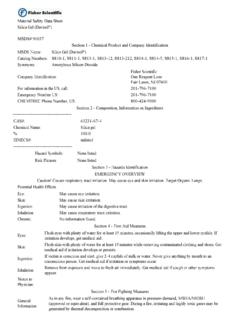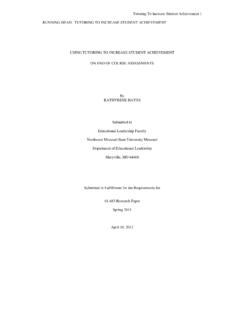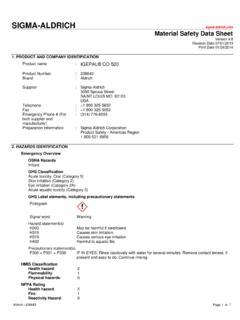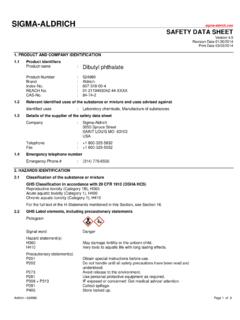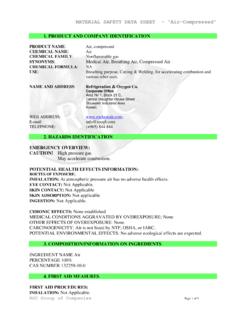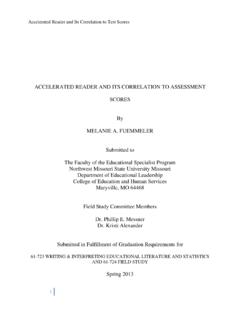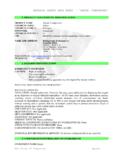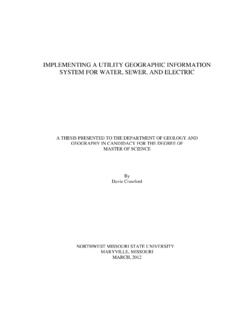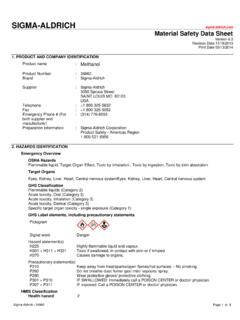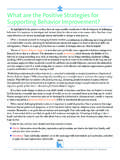Transcription of Positive Reinforcement 1 Running Head: Positive ...
1 Positive Reinforcement 1 Running Head: Positive Reinforcement THE EFFECTS OF POSITVITVE REINFORCMENT ON NON-COMPLIANT BEHAVIOR By MARY JO PETTIT Submitted to The Educational Leadership Faculty Northwest Missouri State University Missouri Department of Educational Leadership College of Education and Human Services Maryville, MO 64468 Submitted in Fulfillment for the Requirements for 61-683 Research Paper [Fall 2012] [May 15, 2013] Positive Reinforcement 2 ABSTRACT This study was conducted to test the impact of Positive Reinforcement on non-compliant behavior. The subject was a seven year old boy on the autism spectrum, in a self-contained classroom setting. Frequency data was taken for one month, when the behavior was ignored, and the following month when Positive reinforcements were implemented.
2 A t-test was generated and showed a significant difference in the student s behavior between the first and second month. This concludes that Positive Reinforcement did minimize this student s non-compliant behavior. It is recommended that further studies are conducted in other grade and age levels, as well as in a whole group setting. Positive Reinforcement 3 INTRODUCTION Background, Issues and Concerns Working with students who exhibit behavioral challenges can be difficult for educators. It is important to not only understand the function of the behavior, but ways to extinguish it. Although aggressive behaviors, as well as elopement can be the most severe and dangerous, compliance is a behavior that can occur most commonly, especially when working with students on the autism spectrum.
3 It is important for educators to gain compliance from students through a means that is Positive , and not punitive. Educators must shape the behavior of non-compliance and teach students to be compliant for the Positive aspects of it, and not because a punishment will ensue. A concern that can arise when dealing with non-compliant behavior is if the behavior is addressed in a punitive way, or not addressed at all. The proper implementation of Positive Reinforcement is something that can be faded over time, which allows the student to learn to be compliant for the sake of being compliant. When a punitive action is paired with non-compliance, it is difficult to fade, and more difficult for a student to learn compliance for an internal purpose, and not just for the sake of staying out of trouble.
4 Practice under Investigation The practice under investigation will include the study of one particular student. It will compare his compliance behavior when no Positive reinforcements are in place, and the difference in compliant behavior, if any, once Positive reinforcements are introduced and implemented throughout an extended period of time. Positive Reinforcement 4 School Policy to be Informed by Study In a school designed to meet the needs of students with significant behaviors, we have adopted The Big 3 as a school wide expectation. They are as follows: Be Safe Be a Worker Follow Directions The student being studied for this case is required to abide by The Big 3 each day. Compliance directly relates to Follow Directions.
5 Conceptual Underpinning Positive Reinforcement as a concept was introduced by the behaviorist Skinner, in his acclaimed text Operant Behaviour and Operant Conditioning. Skinner's idea was that if a person was rewarded for acting in a Positive way, they would come to see that behavior as the most natural and advantageous way to act. Positive Reinforcement is any type encouragement that follows a desired behavior, and is implemented to emphasize the positivity of the action. As a result, the student feels compelled to repeat the desired behavior that earned the praise in the first place. Educators use Positive Reinforcement to increase the likelihood that a desired behavior will reoccur again and again. Positive Reinforcement increases student s self-awareness, and provokes confidence as the student understands what they are expected to do.
6 When teachers use specific praise, it helps the student to understand exactly what they have done correctly. Finally, continued encouragement for Positive actions can have long-standing effects on students, especially those on the autism spectrum. Positive Reinforcement 5 Statement of the Problem If Positive Reinforcement can extinguish non-compliant behavior, special education teachers, as well as general education teachers need to be able to properly understand and implement Positive Reinforcement to extinguish non-compliant behavior. Purpose of the Study The purpose of the study is to compare the difference between compliant behavior when Positive reinforcements are in place, and when they are absent. The information from the study will help educators working with behavior to understand how to work with non-compliant students and if Positive Reinforcement provides desired results.
7 Research Question RQ #1- Is there a difference in complaint behavior when Positive reinforcements are in place, as opposed to when they are absent? Null Hypothesis HO- There is no difference in complaint behavior when Positive reinforcements are in place, as opposed to when they are absent. Anticipated Benefits of the Study The results of this study will provide educators with the knowledge and understanding of Positive Reinforcement and the effect on behaviors, such as compliance. Positive Reinforcement 6 It will allow an in depth look into how the right type of support(s) can assist in changing behaviors. Definition of Terms ASD- Autism Spectrum Disorder The Autism Society of America defines autism as a complex developmental disability that typically appears during the first 3 years of life.
8 The result of a neurological disorder that affects the functioning of the brain, autism impacts the normal development of the brain in the areas of social interaction and communication skills Discrete Trail Training- a method of teaching simplified and structured steps, instead of teaching an entire skill. The skill is broken down into smaller steps using discrete trials that teach each step one at a time. This is a widely used practice when teaching students on with ASD FBA- Functional Behavior Assessment Functional assessment of behavior is a process for identifying clear, predictive relationships between events in the child s environment and the occurrences of a target behavior Positive Reinforcement 7 PECS- Picture Exchange Communication System A form of alternative and augmentative communication that uses pictures instead of words to help children communicate.
9 PECS was designed especially for children with autism who have delays in speech development Positive Reinforcement - the addition of a stimulus to increase or maintain frequency of a behavior SPED- Special Education Education for students (such as the physically or mentally disabled) with special needs Summary A study was conducted to test if the use of Positive Reinforcement , and highly rewarding reinforcers would extinguish non-compliant behavior. A student was observed for two months and data was collected on non-compliant behavior with and without the use of reinforcements. It is important to note that not only were the use of Positive Reinforcement absent, but negative Reinforcement was absent as well. The student s self-motivation to comply was observed without any type of supports.
10 After an extended period of time, and a measureable amount of data was collected, Positive reinforcements were introduced. The student was highly reinforced by teacher praise, peer approval, a visual token economy board, and tangible items such as an iPad. Positive Reinforcement 8 REVIEW OF LITERATURE Positive Reinforcement as a concept was introduced by the behaviorist Skinner, in his acclaimed text Operant Behaviour and Operant Conditioning. Skinner's idea was that if a person was rewarded for acting in a Positive way, they would come to see that behavior as the most natural and advantageous way to act. As such, Positive Reinforcement can help to encourage good behavior in young learners from an early age. Positive Reinforcement can either be a reward for good behavior, or simply Positive communication in the form of praise or encouragement.
